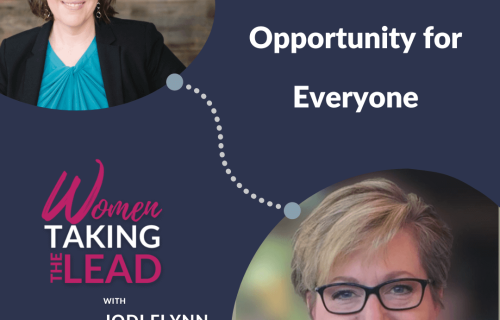
100% Jodi: You, Seeing from Multiple Perspectives
Click the play button to listen to the podcast episode.
Have you experienced the eye-opening magic of seeing from more than one perspective?
When we are children, we believe we are the center of the universe. At that stage in life, we have a difficult time considering why someone would see things differently than we do.
In fact, if someone didn’t agree with us, we made up a story about why this person could possibly not agree with our outlook.
It takes work to shake out of this default way of thinking and start making a habit of considering how other people are seeing things. However, the reward of staying open-minded and seeing things from multiple perspectives has many benefits. Notwithstanding, there are new ideas, new opportunities and new solutions that you may have missed if you only look at things from your own vantage point.
Now take this ability as an individual and add to it a diverse team of people who all see the world differently. If this team can respect and appreciate each other for the unique perspectives and experiences they all bring to the table, this is your dream team.
In this episode, we’re going to cover the skills of considering and incorporating multiple perspectives as a leader, why it’s so important, and how you can incorporate it into your leadership.
Multiple Perspectives Introduced by a Friend
When I moved to Maine for a job in 2002, I was joined by others who had worked for my previous employer. I was now reporting to an individual I knew from my previous job. My new boss and I had not worked closely together, but a friend of mine had.
Within six months of this new reporting relationship I was on the phone with my friend incredibly frustrated by my new boss. On of my biggest grievances was how he was approaching different situations.
My friend had sage advice on working with her old boss, now my new boss. She suggested thinking about what motivates him. What she knew motivated him was a desire to go home at night and not think about work too much. He did not want to lose sleep over any decision that was made during the day.
This perspective opened my eyes to seeing him in a whole new light.
He was risk adverse.
All the questions he asked that I found to be annoying, were actually designed to gauge risk. His desire to change policies and procedures every time a mistake was made came from a place of never wanting to make the same mistake twice.
I still didn’t agree with all of his concerns and recommendations for changes but I now could understand and speak to the concerns that he had. I got into a habit of, before meeting with him, trying to think of all the questions he would have for me and pulling data that substantiated by point of view.
In this regard, without even trying, he made me a better leader and employee.
He also had this habit of playing devil’s advocate without telling you he was Playing devil’s advocate. As you can imagine this would often shoot my stress level through the roof. I thought he was questioning my competency and my ability to do my job. Once I realized where this was coming from it no longer bothered me.
The Ability to Consider Multiple Perspective Improves Relationships
This new perspective on my boss gave me such freedom and improved our relationship significantly. I could now appreciate him and what he brought to the table.
The conversation I had with my friend and former colleague had me paying closer attention to what motivated the other people I worked with and how they preferred things to be.
Years later, after I started my own business and while I was doing some contracting work for a training and development company, I learned to facilitate the training on the Everything DiSC Workplace Indicator.
The DiSC Indicator
If you’re not familiar with DiSC, this is a personality indicator designed to capture your communication preferences and teach you about other styles of communication that your co-workers might prefer, and how to bridge the gap between your preferred style and theirs.
Having become familiar with this tool and looking back on my old experiences, my former boss fell perfectly into one of the quadrants in the DiSC indicator. His desire to avoid risk, to have all his ducks in a row, his aversion to surprises… it all made sense.
The ability to step out of your shoes and into another’s shoes, to attempt to see the world from their perspective, to wonder what is influencing their behavior, it is incredibly powerful. It’s not the place where you draw your final conclusions but it’s an opportunity to consider something new. Especially when someone’s behavior does not make sense to you.
Taking Multiple Perspectives to the Level of Team
First, let’s distinguish perspective from reality.
You want to think about perspective as the vantage point from which you see the world. Your perspective is shaped by your life experiences, values, beliefs, current state of mind, assumptions brought into a situation, among other things. It shapes how you act or react in a situation.
You can see why, even though you and I might be in the same situation at the same time, we could walk away with two different reports of what happened. This is because our life experiences, beliefs, values, etc., are somewhat different. These factors influence what we observed, how we interpreted what was happening, and the conclusions we came to.
As an aside, if ever you are at a loss for why someone thinks the way they do, why they say what they say and do what they do, this is what you are missing.
Your perspective is a slice of reality. When you look at the shared reality of situation, the more diverse perspectives you get, the closer to reality you will get.
Why We Are Sometimes Not Open to Multiple Perspectives
Sometimes its uncomfortable to consider someone else’s perspective, especially when it diverges from your version of reality, because it calls into question things you hold as true.
This is why sometimes we want to spend time with people who share our own values and see the world the way we do. It’s comfortable, it feels stable, and it doesn’t ask too much of us.
When you are open minded, you have your perspective, but you are willing to at the very least consider that something else might be true as well.
The benefit of being a little uncomfortable and taking in other perspectives is the literal and figurative vision you gain from it. By considering multiple perspectives you compound the amount of information and opportunities available to you at any time.
Things that are in your blind spots can be seen by others. And once they point these things out to you, your blind spots have become that much smaller.
According to Steffan Surdek, a corporate consultant, trainer, and contributor to Forbes, ““We live in a professional world that goes fast and where people do not always take the time to step back. When going fast, leaders often confuse their perspectives with reality and have difficulty truly understanding the point of view of others.”
And according to the World Economic Forum, there is a vast amount of research showing that diversity increases profitability and creativity. Organizations with employees of diverse backgrounds have stronger governance and better problem-solving abilities.
Developing Multiple Perspectives as an Individual
Seeing things from another perspective is difficult when we are emotional. For that reason, I recommend pausing and taking time to reflect on the people in your life whom you might feel at odds with.
My clients and I do this together quite a bit. Especially when they are trying to untangle a sticky situation or considering what might be the best approach to a situation.
In the safe space of our meeting, we explore together all the pieces of data that my client has collected about other people in their life and we consider what might be true for the other person.
My client and I consider the other person’s values, motivations, past experiences that may be influencing current events, their challenges, etc. The goal is to help them humanize the other person as much as possible.
When we, all of us, focus have experienced the unpleasant aspects of another person, it becomes too easy to label them as lacking in some way and dismiss them. When we do this, we limit what’s possible in that relationship and our own possibilities as well.
I would encourage you to do this exercise to consider with fresh eyes, the people around you and how they might be experiencing whatever is going on currently at work. If you struggle with this, and it can be hard especially if there is a lot of history with a particular person, ask a neutral person to help you do the exercise.
Your Adversaries Can be Your Greatest Asset
A quick aside here, if you do have someone in your life whom you have a lot of tension with because they operate differently or see things differently from you. When I was facilitating workshops on the Everything DiSC Workplace indicator something that surprised me began to emerge.
Whenever the participants and I did the exercise to explore how to bridge the gap between yourself and someone who has the opposite preferred communication style I would hear from several people in the room:
- “You just described my husband to a T”
- “That’s my wife”
- “Oh, my best friend has that communication style”
When we don’t appreciate what someone brings to the table, they can become our rival or nemesis at work, but when appreciation and respect is there, they are often the person who makes you better.
Those who don’t see or experience the world the way we do are the greatest access we have to seeing our blind spots. They can see what is holding us back.
Creating Multiple Perspectives on the Team Level
In regard to having diverse voices in your workplace, start with taking stock of how diverse, or not, your organization is. Get grounded in the current reality and be clear on what your commitment is to creating not only a more diverse environment, but an environment that is welcoming of diversity.
Hire for Multiple Perspectives
When hiring, go beyond employee referral programs, which tend to bring in more like-minded individuals. Open the job up to candidates outside your company’s inner circle. Check the language of the job posting to make sure it uses inclusive language. There are apps and extensions out there that help with this.
If you want a more diverse pool of candidates, you want to ask where your company is participating in job fairs and where they are posting available internships. Campuses that have a diverse student body are your best bet.
Create a Culture of Diversity and Inclusion
To have this dynamic of multiple perspectives work on your team, you also need to make diversity, inclusion, respect, and understanding different populations and cultures part of your team’s learning and development.
Each member of your team needs to feel valued and appreciated by all members of the team in order to feel that their workplace is a safe environment to share their thoughts and disagree.
As the leader, it’s important for you to model the behavior you want to see. If you want to get the value of multiple perspectives you need to be willing to listen, genuinely consider the other perspective, and when appropriate, acknowledge when you’ve been given the gift of seeing things differently.
There’s nothing wrong with acknowledging that you’ve been corrected or that you had it wrong previously. On the contrary, it is a strength as a leader and demonstrates that it’s okay for each member of your team to own when they had a limited point of view and when they’ve been offered by another person the opportunity to see things differently.
I invite you to consider how you can invite and develop more diverse perspectives on your work team and in your life.
“A diverse mix of voices leads to better discussions, decisions, and outcomes for everyone.”
Sundar Pichai, CEO of Google
Are You Done with the Struggle? Let’s Chat!
If your last promotion left you feeling unstable in your leadership role, I invite you to consider working with me. I would love to support you through this transition, help you get your bearings and feeling confident in your leadership once again. Schedule a time to chat with me.
This checklist will help you prepare to ask your company to sponsor you to work with a coach. https://womentakingthelead.com/checklist
As always, I hope this was of value to you, and here’s to your success!
Resources
Accomplished: How to Go from Dreaming to Doing. The book containing a simple, step by step system that gives you the foundation and structure to take your goals and make them happen.
The Women Taking the Lead Podcast
If you enjoyed this episode, follow in Apple Podcasts, Spotify, Google Podcasts, iHeart Radio, Stitcher Radio, Amazon Music or Pandora and never miss out!


